"'I have a crisis for you': Women Artists of Ukraine Respond to War" acts as an archive of witness and response
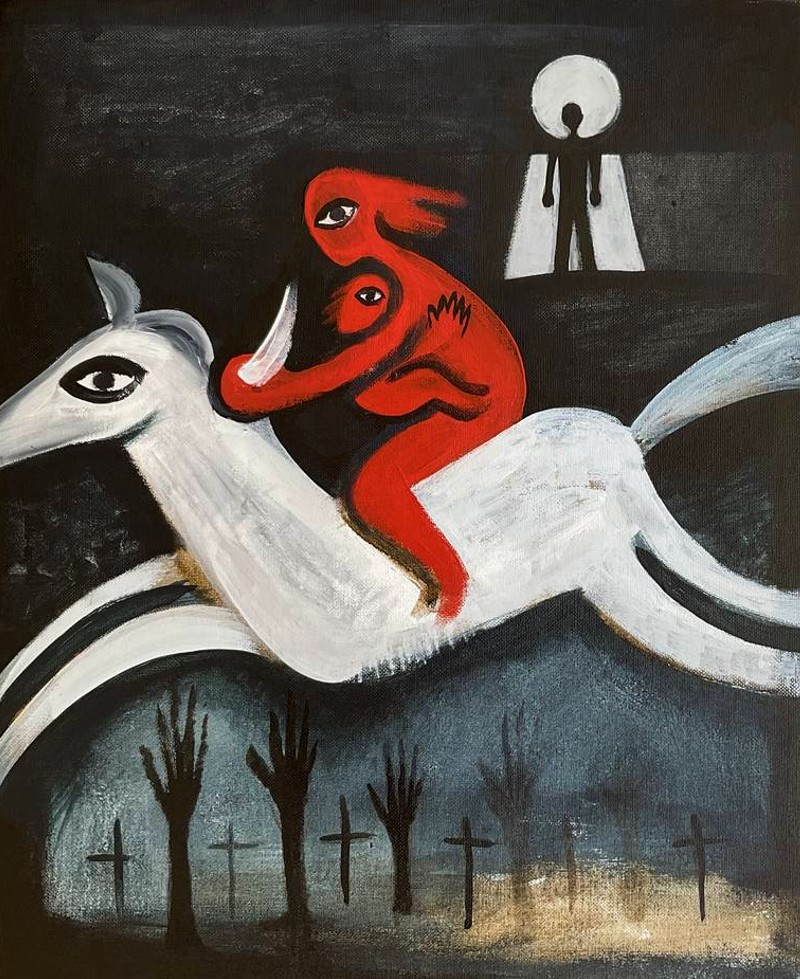
"I have a crisis for you": Women Artists of Ukraine Respond to War was first shown at the University of Michigan's Lane Hall Exhibit Space last August 25 through December 16, and it was brought to U-M's Weiser Hall from January 3 through February 23.
And the curators don't think the exhibition is complete.
“I can’t say it's a finished project, because it will have afterlives,” said co-curator Jessica Zychowicz, director of the U.S. Fulbright Program in Ukraine, who also earned her Ph.D. from U-M.
She and co-curator Grace Mahoney—a Ph.D. candidate in Slavic languages and literatures, and a graduate fellow for exhibits at the Institute for Research on Women and Gender at U-M—hope the multimedia exhibit keeps finding new venues beyond Ann Arbor and can serve as an educational tool, or at least serve as an archive of work in which women describe and respond to their own particular experiences of war.
"I have a crisis for you" features paintings, writing, photos, and more by:
- visual artist and sculptor Kinder Album
- photographer J.T. Blatty
- visual artist and U-M grad student Oksana Briukhovetska
- visual artist and designer Sonya Hukaylo
- filmmaker, artist, and performer Oksana Kazmina
- visual artist Lesia Kulchynska
- poet and translator Svetlana Lavochkina
- visual artist Kateryna Lisovenko
- poet and screenwriter Lyuba Yakimchuk
Zychowicz and Mahoney did their curation remotely: Mahoney from Ann Arbor; Zychowicz from Warsaw, Poland, where she moved from Kyiv when the invasion began. To inform the project, the curators drew on previous relationships they had with the artists and writers as well as their own scholarship: Zychowicz is the author of Superfluous Women: Art, Feminism, and Revolution in Twenty-First Century Ukraine, and Mahoney is the series editor of Lost Horse Press' Contemporary Ukrainian Poetry Series.
Zychowicz and Mahoney recently talked with me over Zoom to discuss the exhibit. Our conversation was edited for clarity and length.
EMU's "King Kong at Ninety: Visualization in the Art of Stop-Motion Animation" celebrates the creativity behind the film that helped launch the Creature Feature
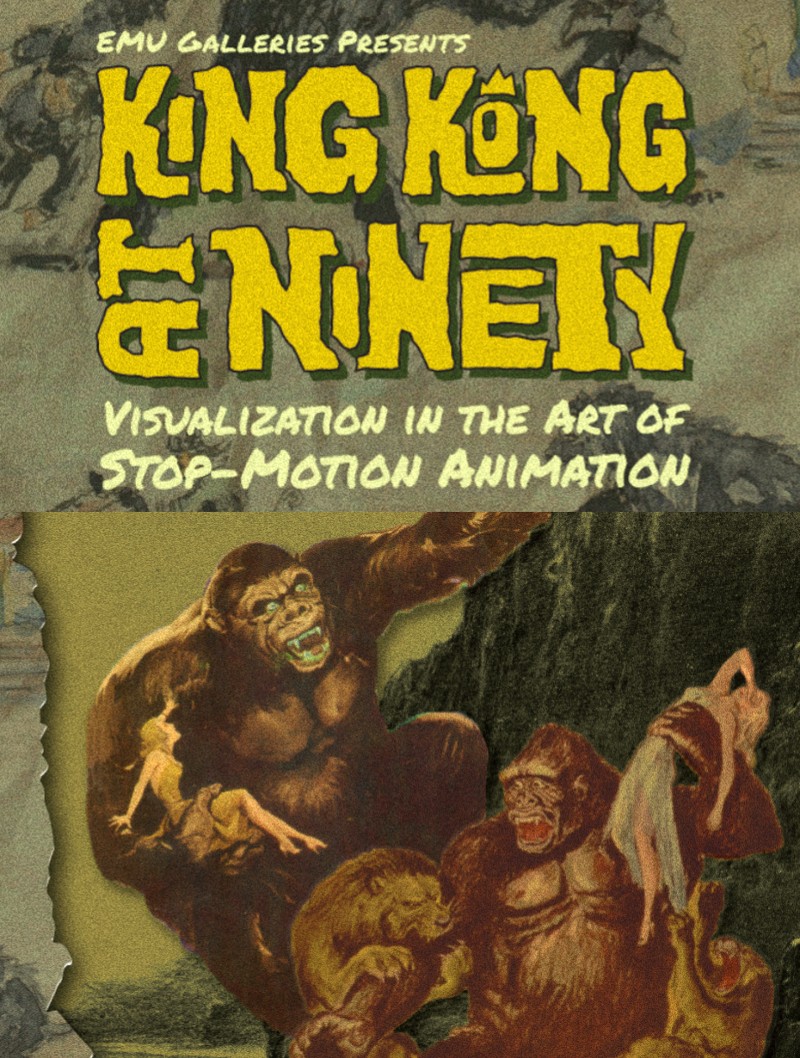
While spending an hour-plus perusing Eastern Michigan University’s exhibit King Kong at Ninety: Visualization in the Art of Stop-Motion Animation, I was struck by how, in some ways, it’s probably harder for young film buffs to stumble upon the old classics.
Admittedly, nearly all movies that survived are available to us at any moment now, but that tsunami of choices also means viewers must specifically seek out a film like King Kong (1933) instead of merely tumbling out of bed before your parents get up on a Sunday morning, turning on the TV, and sampling that week’s “Creature Feature”—a genre largely spawned by the runaway blockbuster success of King Kong.
Even so, as demonstrated by King Kong at Ninety—on display at EMU's University Gallery through February 23—theatrical rereleases of the film served this same purpose for years, offering moviegoers multiple opportunities to experience what were, at the time, cutting edge, eye-popping visual effects. (It’s interesting to note how the poster art changed with each release, as well as how it was visually marketed in other countries.)
Plus, EMU’s exhibit offers up Depression-era magazine features dedicated to revealing how these cinematic images were achieved—though more of these articles trafficked in shoddy guesswork (i.e., an actor in a gorilla suit) than in accurate, researched reporting.
But even these misinformed attempts hint at the widespread sense of wonder and curiosity inspired by King Kong. So how did this seminal movie come to be made?
Open the Vaults: Tania El Khoury's multimedia installation “Cultural Exchange Rate” immerses you in the artist's family history

If you could unearth all the secrets of your family’s past, would you?
Lebanese artist Tania El Khoury set out to do that with her interactive art installation Cultural Exchange Rate, which is presented at the Stamps Gallery, courtesy of UMS, until January 29. The multimedia work tells the artist's mission to trace her family’s roots by having gallery-goers open locked boxes and stick their heads inside to see videos, sounds, objects, and images of El Khoury's family journies between continents.
Originally from Akkar, a small village in Lebanon located near the river that separates Lebanon and Syria, El Khoury’s great-grandparents migrated to Mexico during a civil war. Her grandfather was born in Mexico, but her family eventually moved back to Lebanon, where he collected old coins and Lebanese liras, hoping they would be worth more than their original value one day when the currency exchange rate changed.
The story progresses to the present, with the artist becoming pregnant. In hopes of giving her unborn daughter citizenship in a country with a better passport and more cultural freedom, El Khoury searches for her grandfather’s birth certificate in Mexico, so her daughter can gain Mexican citizenship. The journey is frustrating, and while she hits a lot of dead ends, she also discovers family members in Mexico City that she didn’t know she had. Her story is one of blended cultures, resilience, survival, and hope.
New AADL Video Showcases Photographer Josh Lipnik’s “Up North: An Architecture Road Trip” Presentation

Architecture aficionados who don’t want to leave their houses can now take a virtual road trip to Northern Michigan with photographer Josh Lipnik.
An Ann Arbor District Library video from Lipnik’s January 17 slide show presentation, “Up North: An Architecture Road Trip,” is now available for viewing.
In “Up North,” Lipnik travels through small Northern Michigan towns to find the marvelous facades, neon signs, elaborate Victorians, and architectural trends that time has left behind.
He offers his evocative pictures to tell the story of immigrants, industry, and the role of local resources and geology while reflecting on his time on the road.
Lipnik runs Midwest Modern, a platform for photography, research, and writing about architecture and design. He is also a graduate of the University of Michigan’s Taubman College of Architecture and Urban Planning and The Ohio State University’s College of Engineering.
“The Plastic Bag Store” Uses Art to Raise Awareness About The Pervasive Problem of Plastic Packaging
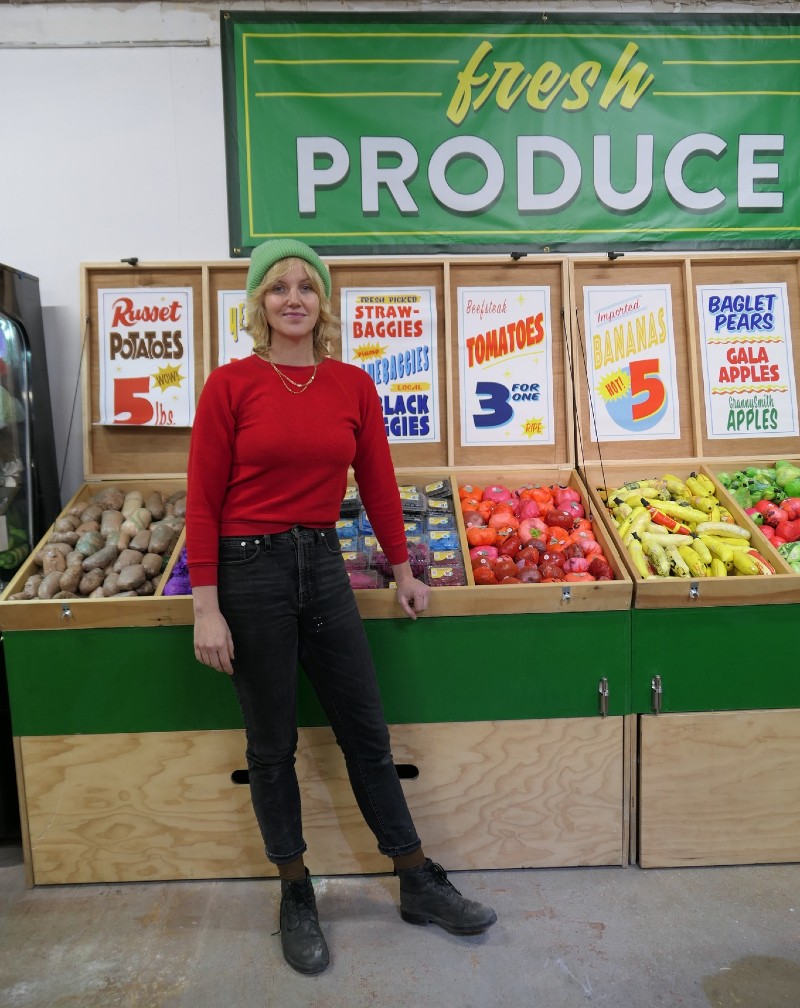
It’s an unnervingly perfect coincidence that when you emerge from the installation/play The Plastic Bag Store (TPBS) presented by University Musical Society (as part of its No Safety Net series), you see a cafeteria space with boxes of individually packaged snacks for sale on a rack.
Why? Because if there’s one thing TPBS achieves, it’s a newly heightened, re-calibrated sensitivity to the layers of packaging that surround us so constantly that we don’t even register them anymore.
In the show’s program – which is, fittingly, only available via a QR code – creator Robin Frohardt explains that the show was born in 2015, “after watching someone bag and double bag all my groceries that were already bags inside of bags inside of boxes. I wanted to highlight the absurd amount of packaging we are using and throwing away by making something even more absurd: a grocery store that only sold packaging.”
But the packaging in TPBS are fashioned to resemble typical grocery store fare: produce, seafood, bakery desserts, flowers, and salads, as well as boxes of familiar-with-a-twist items like Caps N’ Such cereal, Straws (instead of Stroh’s) ice cream, Bitz of Plastic Crap.
AADL 2022 Staff Picks: Homepage
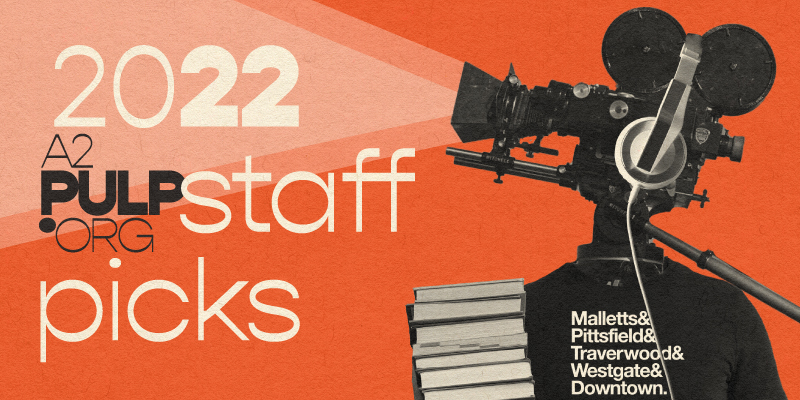
Don't ever write a year-in-review intro before you've had lunch. See below for reasons:
2022 is Pulp’s sixth year of compiling a delectable list of Ann Arbor District Library staff picks, featuring a smorgasbord of media to review and devour. With an insatiable hunger for books, films, TV shows, podcasts, music, and more, our AADL staffer suggestions will whet your appetite for anything you may have missed in 2022—or from previous years.
Because who can keep current with everything on the media menu these days?
The current media landscape is a 24-hour grocery store with everything everywhere available all at once. It’s decision paralysis at the deli counter, so consider us your Instacart shoppers for things to read, watch, play, listen to, and experience. (Apologies if we missed anything on your shopping list, and we hope our substituting a banana for that frozen pizza is OK.)
With more than 36,000 words to ingest in the 2022 Staff Picks, we’ve divided everything into four separate courses so you can enjoy each portion at your leisure:
➥ AADL 2022 Staff Picks: Words
➥ AADL 2022 Staff Picks: Screens
➥ AADL 2022 Staff Picks: Audio
➥ AADL 2022 Staff Picks: Pulp Life
If you feel inspired as you eat up our words, let us know in the comments sections what you sank your teeth into this year. Your tasty tips can be from 2022 or any other era; it just needs to encompass whatever art, culture, or entertainment you enjoyed over the past year.
Now, open up these posts and chow down.
We’re off to make some spaghetti.
Andrea Carlson's "Future Cache" exhibit at UMMA imagines decolonized landscapes for the native peoples violently removed from their land

“Gidayaa Anishinaabewakiing / You are on Anishinaabe land”
The title of Andrea Carlson’s multidimensional installation Future Cache at the University of Michigan Museum of Art (UMMA) references the Anishinaabe storage practice of using underground caches to store supplies through the seasons.
The centerpiece of Future Cache, however, doesn't train your gaze toward the ground but up to the sky.
UMMA's Vertical Gallery has a towering 40-foot-high wall of memorial text. Written by the Burt Lake Tribal Council and presented in Anishinaabemowin (translated by Margaret Noodin and Michael Zimmerman Jr.) and English, the words commemorate the historical and ongoing effects of colonial violence on the Cheboiganing (Burt Lake) Band of Ottawa and Chippewa Indians.
On the lower level, a cache of Carlson's paintings complements the tower of text with imagined decolonized landscapes, as well as two carefully selected artifacts. Curator Jennifer M. Friess writes in the gallery text that Carlson aims "to draw attention to the theft of Indigenous land and to express solidarity with Indigenous communities on the long journey toward restitution.”
"Conversations on Mortality" at 22 North looks to transcend the silence about the dying side of living

Conversations on mortality are difficult, often avoided, and in America, they are traditionally taboo. The 22 North gallery in Ypsilanti welcomes the thought-provoking exhibit Conversations on Mortality, which confronts our impermanence, the inevitability of death.
The exhibition's multimedia works engage with loss, mourning, and what is left behind once someone is gone. Described by the curators as “a chance to transcend the silence,” Conversations on Mortality offers works driven by the lives of the artists. Not only do they address the complexity of their mortality and loss of loved ones, but also their experiences of living with disability, illness, and the impact of COVID-19.
Entering the space, hanging lanterns in an autumnal palette cheerily frame serendipitously matching works by curators Sharlene Welton and Tim Tonachella. I had a chance to speak with Welton who is both the show’s curator and an artist when I visited 22 North. Welton said she created the lanterns as part of an interactive element to the opening night, where visitors were able to decorate and write their names on the lanterns before hanging them. The pieces by Welton (a large painting) and Tonachella (two photographs of cemetery views) were brought in last minute when an artist was unable to make the show, but adding the works ended up being a great aesthetic success.
Welton and Tonachella’s gallery statement notes the overlapping threads among the works, as artists grapple with the questions, “How do we embrace the changes that come from death and dying, and more importantly, how we assimilate the loss into our daily living?” Though these may, ultimately, be unanswerable questions, they are worth asking—especially when operating within a mainstream American culture that predominantly ignores them.
Things to Do: Pulp Event Roundup for November

To fill up your November calendar, we’ve compiled a comprehensive list of arts-related events, exhibits, and more throughout Washtenaw County. Check out some local cool happenings in music, visual art, theater and dance, and written word and film.
MUSIC
Bill Edwards
November 11
Canterbury House, Ann Arbor
Ann Arbor singer-songwriter and multi-instrumentalist Bill Edwards performs tracks from his new Americana album, Thirteen Stories. Throughout his latest release, Edwards pens sentimental stories from different perspectives, including a hall-of-fame baseball player, a seasoned songwriter, and a nostalgic boater. Read our preview and interview here.
Nervous But Excited
November 11
The Ark, Ann Arbor
Ten years after their sold-out finale at The Ark, the local folk duo of Kate Peterson and Sarah Cleaver reunite for one of their final Nervous But Excited performances. Their repertoire ranges from smart, introspective narratives to the tactfully political while interspersing songs of love and loss.
Olivia Van Goor
November 11
Blue Llama Jazz Club, Ann Arbor
The Milford jazz vocalist is influenced by swing and bebop jazz from the mid-20th century. Van Goor unearths and reshapes gems from the Great American Songbook and other jazz standards in a way that’s beyond replicating what has already been done before. Read our past interview with Van Goor here.
John Gutoskey’s vibrant “Cake & Flowers for My People” exhibit preserves ephemeral arrangements denied to LGBTQ+ marriages and events
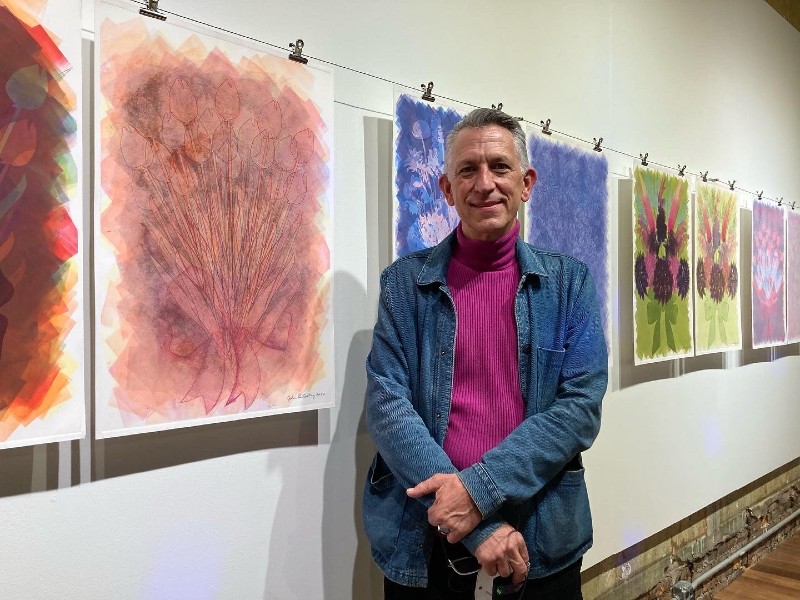
John Gutoskey’s vibrant, kaleidoscopic Cake & Flowers for My People exhibit honors LGBTQ+ community members who have been denied these celebratory arrangements due to bakers and florists citing religious objections to same-sex marriages and queer events.
“I make a lot of work about queerness because a lot of stuff is happening around it in our country. You see the whole pushback now,” said the Ann Arbor artist-designer-printmaker, whose exhibit runs through October 30 at Ypsilanti’s 22 North gallery. “I just hope anybody who sees it … feels seen and knows they’re not alone.”
The welcoming aesthetics of Gutoskey’s exhibit run throughout the eight mixed-media cake sculptures and 39 floral bouquet monoprints. An electrifying spectrum of color elicits feelings of empowerment, unity, and hope for all who experience Cake & Flowers for My People.
“People are kind of overwhelmed with how hard the world has become, so I just wanted to do something that was fun,” he said. “There’s enough stuff to be down about. Let’s celebrate it, honestly, while it’s still legal for [us] to do so.”


































